Grease analysis poses some unique challenges. Sample size is often very small yet contamination levels and particle sizes involved are often anything but! The most challenging bit is getting the sample dilute enough to pass through the fine capillaries of an ICP without clogging them up and damaging the instrument. And that’s before you start looking at the size of the debris! And the larger particles quickly settle in the low viscosity solvent mixture, avoiding detection.

How do we manage? We use a Rotating Disk Electrode spectrometer instead*. Problem solved.
In an RDE Spectrometer the sample is picked up by a rotating disk electrode dipped into the test pot. Energy is then introduced into the system in the form of an electrical spark. Light emitted by the energised sample is collected and analysed with levels of multiple elements obtained by comparison to a calibration standard.
*We do also use the ICP to measure some of the additive elements and get the large to small ferrous debris ratio.

Routine Analysis
A check of water content, PQ Index and Elemental Analysis.
Sample Preparation
Grease analysis starts with sample preparation. Once all the sample identity details are recorded the sample is mixed thoroughly and a portion is diluted with a blank base oil to facilitate analysis. This will be used for Elemental Analysis via the Rotating Disk Electrode Spectroscopy, PQ Index and Water Content measurements. Where needed, a separate portion of grease is prepared for Analytical Ferrography by dissolving in a mixture of solvents.
Water Content
 Excess water in the oil reduces the lubricating effectiveness by disrupting the oil film, accelerates corrosion (i.e. rusting of iron and steel surfaces), depletes and/or degrades additives and accelerates the aging (oxidation) of oil. Where large quantities of water are present oil may become emulsified. The emulsions can combine with insoluble oxidation products to form sludge which impairs the operation and reliability of equipment. In addition excessive water if present as free water can promote bacteria growth or form hard deposits on bearing surfaces.
Excess water in the oil reduces the lubricating effectiveness by disrupting the oil film, accelerates corrosion (i.e. rusting of iron and steel surfaces), depletes and/or degrades additives and accelerates the aging (oxidation) of oil. Where large quantities of water are present oil may become emulsified. The emulsions can combine with insoluble oxidation products to form sludge which impairs the operation and reliability of equipment. In addition excessive water if present as free water can promote bacteria growth or form hard deposits on bearing surfaces.
An increase in water content may be due to:
- Leaking covers on equipment
- Leaking oil coolers
- Excessive leaking turbine gland steam seals
- Condensation
- Using water contaminated fluid for topping up
Particle Quantifier Index (PQ)
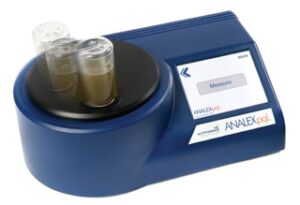
- A measure of total magnetic ferrous debris in the sample irrespective of particle size.
- Does not detect non-magnetic ferrous debris e.g. rust.
- Combine with Elemental Analysis and ISO Code for comprehensive assessment of the wear situation.
Elemental Analysis
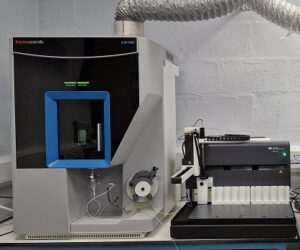 Induction Coupled Plasma Optical Emission Spectroscopy (ICP-OES) is used to measure the concentration of over 20 different elements in the oil. These include wear metals, additives and contaminants. We have recently upgraded our instrument – you can read about some of the resulting improvements here.
Induction Coupled Plasma Optical Emission Spectroscopy (ICP-OES) is used to measure the concentration of over 20 different elements in the oil. These include wear metals, additives and contaminants. We have recently upgraded our instrument – you can read about some of the resulting improvements here.
By monitoring wear metal concentrations the wear rate and its origin can be established. Trending additive levels ensures that the right oil is used and that it remains suitable to the task, while measuring levels of contaminants helps prevent severe wear and loss of function.
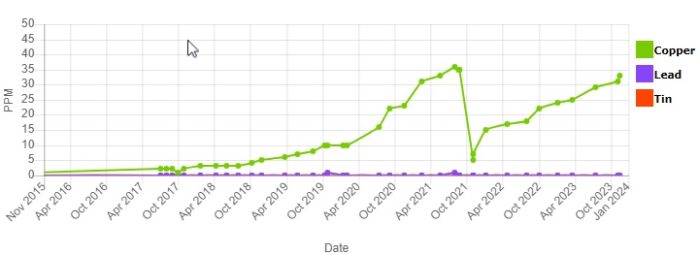
 For grease and debris samples a combination of a Rotating Disk Electrode Optical Emission Spectrometer (RDE) and an ICP-OES is used. The RDE eliminates a lot of cross-contamination issues and, as no dilution with solvents is required, allows for more accurate measurement of heavily contaminated samples which would settle at the bottom of the test tube if an ICP-OES was used. The ICP-OES is then used to cover elements not measured by the RDE (mostly additives, although the wear metals are also measured). The ratio of RDE to ICP wear metal levels gives an indication of wear particle sizes.
For grease and debris samples a combination of a Rotating Disk Electrode Optical Emission Spectrometer (RDE) and an ICP-OES is used. The RDE eliminates a lot of cross-contamination issues and, as no dilution with solvents is required, allows for more accurate measurement of heavily contaminated samples which would settle at the bottom of the test tube if an ICP-OES was used. The ICP-OES is then used to cover elements not measured by the RDE (mostly additives, although the wear metals are also measured). The ratio of RDE to ICP wear metal levels gives an indication of wear particle sizes.
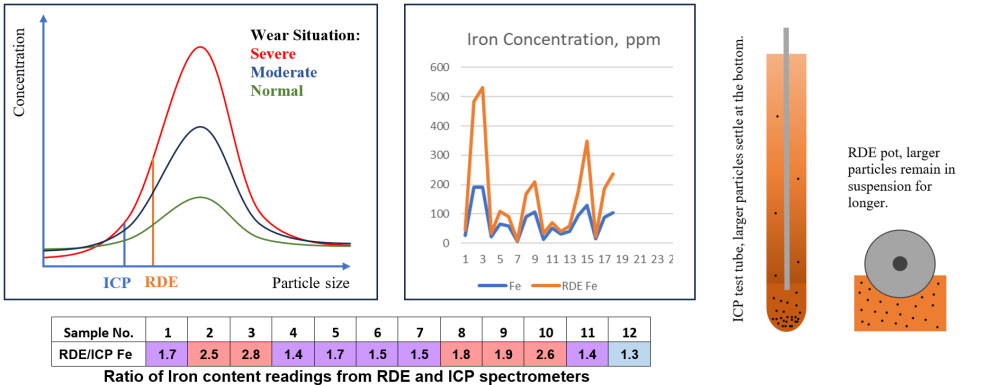
Analytical Ferrography
Sometimes you just have to know more. Have an operation or safety critical asset? A crane on an oil platform? Don’t go any further!
Analytical Ferrography
Analytical Ferrography is a technique for depositing and analysing wear particles contained in an oil or grease sample. The sample is deposited onto a glass slide, with the particles trapped by strong magnets and the oil washed away with a suitable solvent. Both linear and rotary particle deposition systems exist. At STS preference is given to a rotary system, which has been developed at the company. It ensures good separation of particles over the three rings, with particles also being sorted by size with the larger particles settling out on the inner ring.
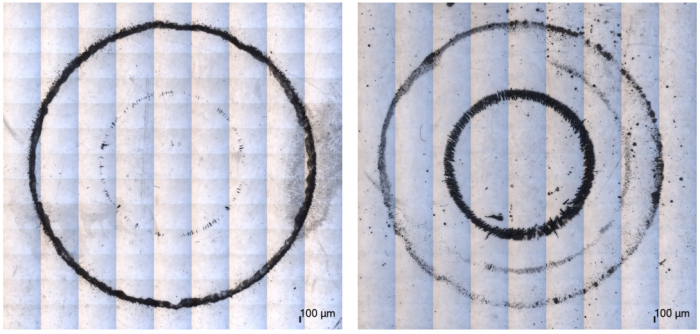
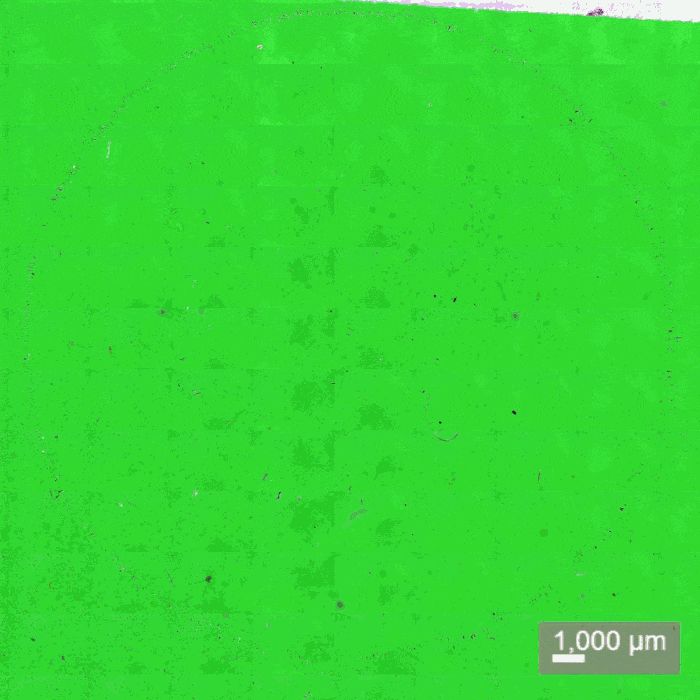
Once deposited the particles are analysed by a metallurgist, who is able to report on the relative quantities, types and sizes of particles present. A Particle Quantifier Index of the slide is also recorded. All of this is taken into account to produce a comprehensive report on the wear rate and situation.

You can find an example Ferrography Report available for download here.
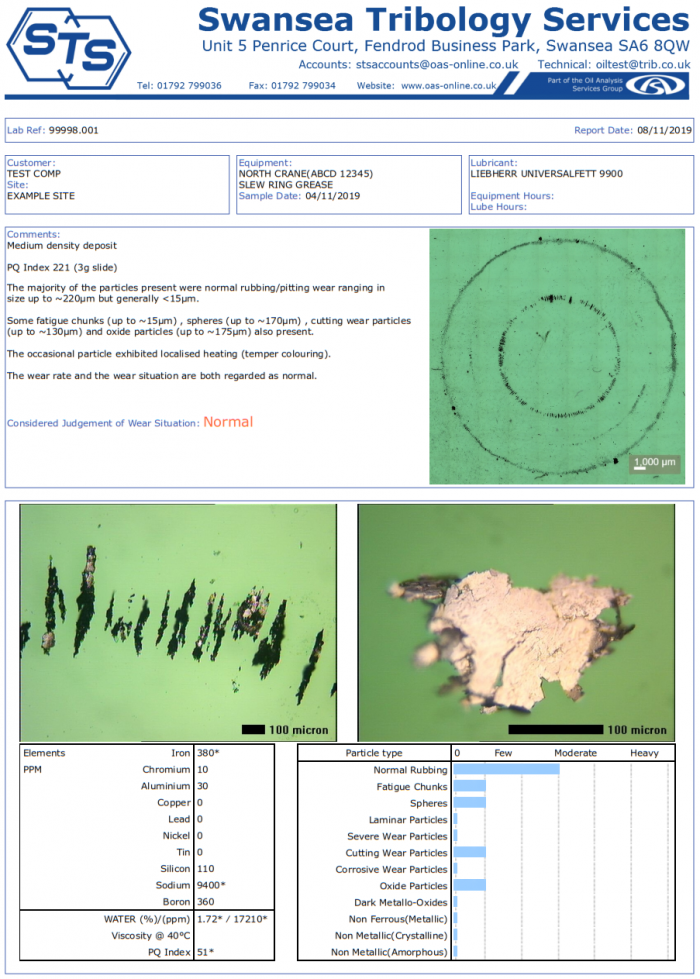
We are now also able to supply Ferrography Slides.
FTIR Spectroscopy Analysis
Want to check if the right grease was used or detect a particular contaminant? FTIR will help.
FTIR Spectroscopy Analysis
Fourier-transfer Infra Red Spectroscopy (FTIR) is a powerful tool for analysis of oil, grease and fuel samples. It is especially useful for monitoring and identifying certain types of contaminants.
The underlying principle is that infrared energy from the source is absorbed in the sample at wave lengths which are characteristic of specific molecular bonds. Each scan generates an FTIR spectrum which can be analysed and interpreted.

At its most basic the technique can be used to measure predetermined parameters, such as oxidation, nitration, sulphation or presence of fuel and glycol in an engine oil. Some of those require prior calibration and a scan of a virgin sample to be used as reference.
More advanced analysis can help monitor degradation, identify and match unknown contaminants, verify lubricant formulation or help identify and source an unknown lubricant.
In some cases Gas Chromatography coupled to Mass Spectroscopy (GC-MS) is called upon to work in tandem with FTIR analysis on particularly tricky samples, where exacting information is nonetheless required.
You can download an Example FTIR Report here
Grease Analysis - Bulk Properties
These tests focus on the performance characteristics and related properties of a lubricating grease sample.
Grease Analysis - Bulk Properties
Some of the key properties covered include:
- Drop Point
- Cone Penetration
- Oil Separation
- Oil Content
- Base Oil Viscosity
- Elastomer Compatibility (Swell)
- Evaporation Loss
- A range Load and Wear Performance Tests.
Many of these require substantial sample quantities and are therefore only available for samples of virgin grease. In some cases a modified miniaturised method exists, making used grease analysis also possible. Get in touch to discuss your specific needs.